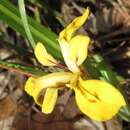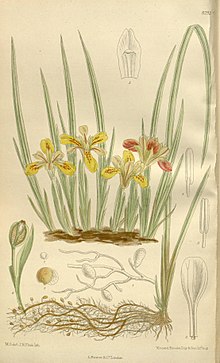fi
nimet breadcrumb-navigoinnissa


Iris minutoaurea is a beardless iris in the genus Iris, in the subgenus Limniris and in the series Chinenses of the genus. It is a rhizomatous herbaceous perennial of eastern Asia, native to China and Korea. It has been naturalized in Japan. It has long grassy-like leaves, short stem and bright yellow or pale yellow flowers. It is cultivated as an ornamental plant in temperate regions.
Iris minutoaurea can sometimes be mistaken for Iris henryi (another yellow flowering Chinese iris). But they differ is sizes of pedicel (flower stalk) and perianth tube. Iris henryi has a short perianth tube and long pedicel, while with Iris minutoaurea it is the other way around.[2]
It has a yellowish brown, slender, wiry, rhizome,[3][4] measuring about 2 cm (1 in) long and 0.5 cm (0 in) wide,[5] that produces many branches and stolons.[6][7] This branching habit forms clumps of plants.[8][4][9] In autumn, the roots (under the rhizomes), produce small nodules.[10] These are used to fix nitrogen, from the soil.[11]
It has grassy, linear, ribbed, 5–16 cm (2–6 in) long and 0.2–0.7 cm (0–0 in) wide leaves.[10][9][7] They appear in early March, they then elongate after flowering up to 40 cm (16 in) long, reaching a maximum height by June.[3][5][7] This elongating leaf habit is also shared by Iris koreana.[12]
It has a very short, slender flowering stem, only 7–10 cm (3–4 in) long.[13][10][9] It has one terminal (at the top of the stem) flower,[3] in spring to early summer,[8][4] in April or May.[6][5][10]
It has 2 lanceolate (lance-like) 4–5 cm (2–2 in) long and 0.5–0.1 cm (0–0 in) wide, spathes (leaves of the flower bud), that are acuminate (ending in a point).[6]
The small flowers come in yellow shades. Between bright yellow and pale yellow.[9][2][14] The flowers are 2.5–3 cm (1–1 in) in diameter.[3][5][4] Which can be compared to the size of a quarter.[15]
It has 2 pairs of petals, 3 large sepals (outer petals), known as the 'falls' and 3 inner, smaller petals (or tepals, known as the 'standards'.[16] The drooping obovate (egg-like) falls, measuring 2.2 cm (1 in) long and 0.8 cm (0 in) wide, have brown or purple marks (dots or lines) on the hafts and in the centre of the petal.[13][5][10] The smaller, paler (in colour) narrow, upright standards are between 1.5 cm (1 in) long and 0.3–0.4 cm (0–0 in) wide,[6] with brown/purple petal stalks.[10][9][2]
It has a slender, 1.5–2.5 cm (1–1 in) long perianth tube.[6][3] It has slender 1.5–2.5 cm pedicel (flower stalk), 1 cm long stamens and yellow-brown anthers. It has 1 cm (0 in) long 0.2–0.3 cm (0–0 in) ovary and 1.5 cm (1 in) long 0.3 cm (0 in) wide, style branches similar in colour to the standards.[6]
After the iris has flowered, it produces a globose (spherical) seed capsule between June and July.[6][5]
The effect of forcing date and temperature on growth and flowering of Iris koreana and Iris minutoaurea has been examined in 2007.[17]
As most irises are diploid, having two sets of chromosomes. This can be used to identify hybrids and classification of groupings.[16] It has been counted twice, 2n=22, Simonet, in 1934; syn. Iris savatieri Nakai and 2n=26, Lee in 1970.[8] It is normally listed as 2n=22.[6][18]

It is written as 小黄花鸢尾 in Chinese script and known as xiao huang hua yuan wei in China.[6][19]
It is written as 금붓꽃 in Korean script.[20]
It has the common names of small yellow-flower iris in Chinese English.[19]
The Latin specific epithet minutoaurea refers to the combination of 2 Latin names, minuto refers to very small (or minute) and aurea refers to yellow.[21] Making 'Small yellow blossoms'.[22]
It was originally published as Iris minuta by Franchet and Savatier in 'Enumeratio Plantarum in Japonia Sponte Crescentium' 2: Vol.42 page521 in 1877.[6][8][23]
It was later illustrated as Iris minute in Curtis Botanical Magazine Issue 8293 in 1910.[3]
Later, Iris minuta was regarded as a synonym of Iris minutoaurea and first published and described by Tomitaro Makino in the 'Journal of Japanese Botany', (Shokubutsu Kenkyu Zasshi) from Tokyo Vol.17 in 1928.[24]
Iris minutoaurea is an accepted name by the RHS.[25]
It was verified by United States Department of Agriculture Agricultural Research Service on 9 January 2003.[19]
Iris minutoaurea is native to the temperate regions of eastern Asia.[19][9] It has a wider geographical area than Iris odaesanensis.[5]
It can be found on the Korean Peninsula, and in Liaoning Province of northeastern China.[26][27][28]
It is also found on Gyebangsan Mountain in South Korea.[20]
It has been naturalized in Japan.[4][5][19]
It grows on forest margins and grassy hillsides.[6]
It has been listed in the flora of vascular plants in the Chilgapsan Provincial Park of Korea.[26] It was listed as 'least concern' on the Red List of vascular plants according to IUCN on Mt. Gilsangsan in Korea.[29] Also listed as 'least concern' on the list of Jeju Island in Korea.[27] It has also been listed as growing on Deokjeokdo.[30]
In Liaoning, China, it was listed as an endemic vascular species, along with Acontium faurieri, Artemisia chienshanica, Betula ceratoptera, Caragana litwinowii, Iris kobayashii, Phragmites australis and others.[31]
Iris minutoaurea has been cultivated in UK, but it is rare,[32] and considered difficult to grow.[13] It is also rare in Europe.[5] It has also, been cultivated in the US but is thought difficult to get it to bloom.[33] It is much easier to grow in Japan, where it has been cultivated for many centuries.[25][14][4]
It is hardy to Zone H2 (which means hardy to −15 to-20 °C (5 to −4 °F [34]), in Europe.[3][35] Although, it has survived in temperatures as low as −29 °C in France.[5] It will be difficult to get to flower in areas of cool summers.[4]
It can be grown in a bulb frame to survive a cold winter or over-watering.[13][5]
It likes to grow in humus-rich, well-drained, neutral to acidic soils.[5][4][10]
It prefers positions in full sun but may tolerate part shade.[5][9]
It does not like positions that get a lot of water,[13][5] preferring well drained, rock gardens and scree-like slopes.[5][10][9]
It can be propagated by division.[5] They need to be divided when ever the clumps of plants get congested and it stops blooming.[15]
It is best planted in September or March.[10] The iris is untouched or undamaged by slugs.[5]
Iris minutoaurea is a beardless iris in the genus Iris, in the subgenus Limniris and in the series Chinenses of the genus. It is a rhizomatous herbaceous perennial of eastern Asia, native to China and Korea. It has been naturalized in Japan. It has long grassy-like leaves, short stem and bright yellow or pale yellow flowers. It is cultivated as an ornamental plant in temperate regions.
Iris minutoaurea là một loài thực vật có hoa trong họ Diên vĩ. Loài này được Makino miêu tả khoa học đầu tiên năm 1928.[1]
Iris minutoaurea là một loài thực vật có hoa trong họ Diên vĩ. Loài này được Makino miêu tả khoa học đầu tiên năm 1928.
小黄花鸢尾(学名:Iris minutoaurea)为鸢尾科鸢尾属的植物。分布于日本以及中国大陆的辽宁等地,生长于海拔500米的地区,常生于山坡及林缘草丛中,目前尚未由人工引种栽培。
금붓꽃은 붓꽃과에 딸린 여러해살이풀이다. 중국과 한국 원산이다.
모양은 붓꽃과 거의 비슷하나 키가 작아 높이가 10-30cm이다. 땅속줄기는 가늘며, 옆으로 길게 뻗는다. 잎은 3-4장 나고, 창 모양이며, 밑이 줄기를 싼다. 꽃은 4월에 꽃줄기 끝에서 1개씩 피고, 노랗다. 열매는 삭과이며, 둥글다.[1]